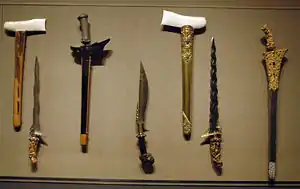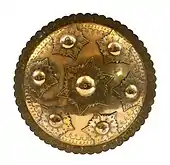Alamang
Alamang (in Bugis language, sometimes Halamang or Lamang)[1] or Sonri (in Makassarese language) is a sacred sword or cutlass of the Bugis and Makassarese people in Sulawesi, Indonesia.
| Alamang | |
|---|---|
 An illustration of an Alamang. | |
| Type | Sword |
| Place of origin | Indonesia (Sulawesi) |
| Service history | |
| Used by | Bugis people, Makassarese people |
| Specifications | |
| Length | 74 cm |
| Blade type | Single edge, flat grind |
| Hilt type | Wood, buffalo horn |
| Scabbard/sheath | Wood |
Description
A sword with a flattened, heavy and deeply indented hilt. The blade's edge and back are straight and parallel. The back curves towards the edge at the point. The Alamang has a straight, plain scabbard with sometimes a small foot. The scabbard's mouth is somewhat broadened.[2]
Cultural
The Alamang is a symbol of sovereignty, prosperity, and dignity of a kingdom. It is said that in the past the king would not leave his kingdom without his Alamang. As it is considered as the greatness of the kingdom, certainly the Alamang is very exclusive. Nobody including the empu (Kris maker) or blacksmith that have sworn, are allowed to make copies the Alamang for it is the weapon of the king. Those who failed to abide by this law were executed.[3]
See also
References
- Richard James Wilkinson (1985). Classic Jawi-Malay-English Dictionary. Penerbit Baharudinjoha. ASIN B0000D7LO6.
- Albert G Van Zonneveld (2002). Traditional Weapons of the Indonesian Archipelago. Koninklyk Instituut Voor Taal Land. ISBN 90-5450-004-2.
- "Senjata Tradisional Nusantara". Archived from the original on 21 June 2014. Retrieved 20 June 2014.
Further reading
- Stone, George Cameron; Donald J. LaRocca (1999). A Glossary of The Construction, Decoration and Use of Arms and Armor: In All Countries and In All Times. Courier Dover Publications. ISBN 978-0-486-40726-5.



